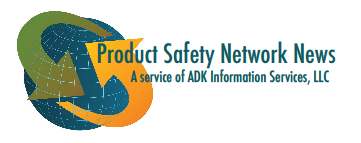Samsung recalls expanding to China after consumer and media complaints
November 2, 2016, National Law Review (Keller and Heckman)
Within weeks of the much-publicized Samsung Galaxy Note7 smartphone recall in North America, a social media and media outcry in China has led the company to expand the recall to cover consumers in that country. The action illustrates a long-standing challenge and two emerging trends for high profile international brands involved in recalls.
Samsung recalls top-load washing machines due to risk of impact injuries
November 4, 2017 cpsc.gov
The CPSC has announced a Samsung recall of 2.8 million top-load washing machines that have tops that can unexpectedly detach from the washing machine chassis during use, posing a risk of injury from impact. The company has received 733 reports of washing machines experiencing excessive vibrations or the top detaching from the washing machine chassis. Nine related reports of injuries have been received.
Proposed Revision of New Safety Standard To Require Vast Majority of Window Covering Products Sold In U.S. and Canada to be Cordless or Have Inaccessible or Short Cords
October 31, 2016, marketwatch.com
The Window Covering Manufacturers Association (WCMA) has announced the first in a series of standard-setting meetings held in accordance with American National Standards Institute guidelines. The WCMA said it would introduce a new approach that would segment window-covering products made by stock and custom products. Under the proposal, all stock products, which make up 80% of products sold in the U.S. and Canadian markets, will be required to be cordless or have inaccessible or short cords.
California releases new Prop 65 warning regulations
November 1, 2016, National Law Review (Schiff Hardin)
California’s Office of Environmental Health Hazard Assessment has finally issued new “safe harbor” warning regulations for Proposition 65, designed to provide consumers “more specificity” about the chemical content of products sold in California. They take affect August 30, 2018. Manufacturers have two options: 1) continue to use the warning language under current safe harbor regulations or, 2) If a manufacturer’s product has previously been the subject of a court-approved settlement or final judgment, any warning language that complies with the or judgment will comply with the new law.
New Proposition 65 warnings rules imposes additional burdens on California Businesses
November 3, 2016, Jdsupra.com (Thomson Coburn)
The new regulations recently announced by California’s Office of Environmental Health Hazard Assessment (OEHHA) impose additional burdens on California businesses, including:
1. Warnings must include the word “WARNING” in all capital letters and bold print. 2. Warnings must name one or more of the listed chemicals for which the warning is being provided. 3. Warnings must include a link to the OEHHA Lead Agency Website. 4. Specific features of the warning symbol graphic design and configuration are outlined. In addition, specific wording is included for exposure to listed carcinogens, listed reproductive toxicants, and both listed carcinogens and listed reproductive toxicants.
Those nasty chemicals in your blue jeans aren’t easy to replace
November 1, 2016, standard.net (Bloomberg)
A “rogue’s gallery” of unpronounceable chemicals whose effects on humans are suspect, are found in jeans and other clothing. Perfluorochemicals, phthalates and azo dyes are among the substances that are widespread in the manufacture of clothes. Under pressure from consumers demanding safer alternatives for harmful chemicals, American companies, including Levi Strauss & Co., are taking a more European Union approach, where over 1,000 chemicals have been banned or restricted, versus the U.S. where fewer than 50 chemicals are in that category, according to the Bloomberg report.
This Christmas 100 Toys-‘R’-Us UK stores will hold quiet shopping events for autism-affected families
October 30, 2016, Babble
With the approach of holiday shopping, which can be packed with stress, stores like Toys’R’Us are taking a more family-friendly approach so that those affected by autism can have the chance to shop together. The over abundance of lights and sounds in many stores can be overwhelming. This year every single Toys’R’Us store in the U.K. will open one hour early for families wanting to avoid bright lights and loudspeakers.
What’s in the declarations that sealed the Canadian-EU trade deal?
October 27, 2016, cbc.ca
A key declaration that helped negotiators conclude their proposed agreement guarantees the both Canada and EU rights will not be violated by any of the treaty’s provisions. Specifically: “CETA will not weaken our respective standards and regulations in food safety, product safety, consumer protection, health, environmental or labour protection. Imported goods, service providers and investors must continue to meet the requirements imposed at the national level, including applicable rules and regulations. The European Union and its member states, on one hand, and Canada, on the other hand, reaffirm the commitments made in terms of the European Union’s precautionary principle in the context of international agreements.”
Post-Brexit: What does the future hold for Britain?
October 4, 2016, Jones Day
An Emerging Issues video series on Brexit has been produced by Jones Day, which analyzes the June, 2016 referendum in which the UK electorate voted to leave the EU, and what impact it will have on London as a financial center, how passporting will play into access within the EU, and the post-Brexit market opportunities for London and the UK.
Why your home should scare the heck out of you
October 27, 3016, Forbes
Forbes analyzes some of the CPSC annual injury data generated from hospital emergency room reports from the agency’s NEISS electronic data collection system. Risks prevail in all parts of consumer homes, including: beds, pillows, and mattresses (773,256 injuries), bathroom structures and fixtures (482,988 injuries), TVs and television stands (59,981 injuries), stairs, ramps, landings and floors (a whopping 3 million injuries annually), and kitchen-related injuries including ovens, refrigerators, and freezers (48,938), and clothing (345,836).


